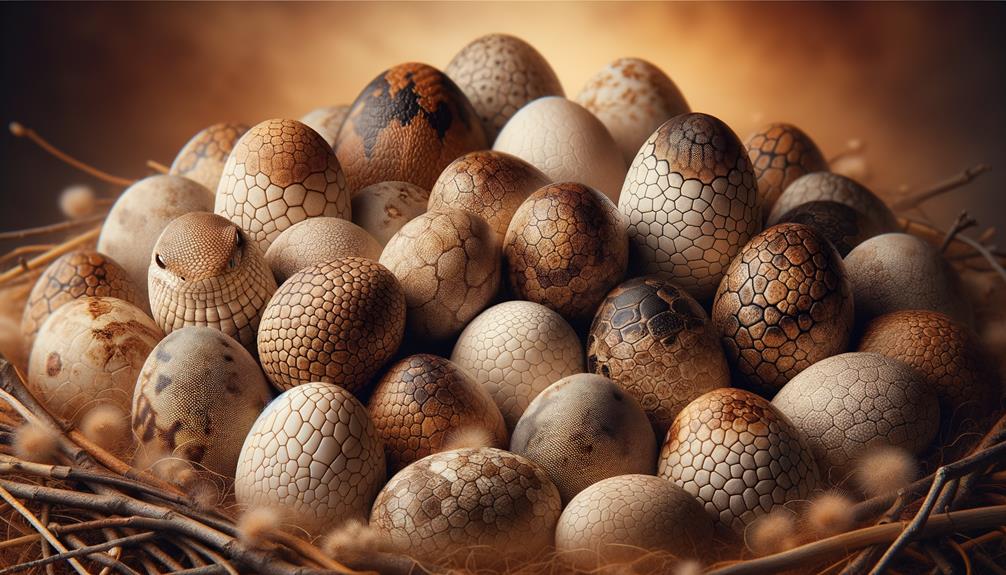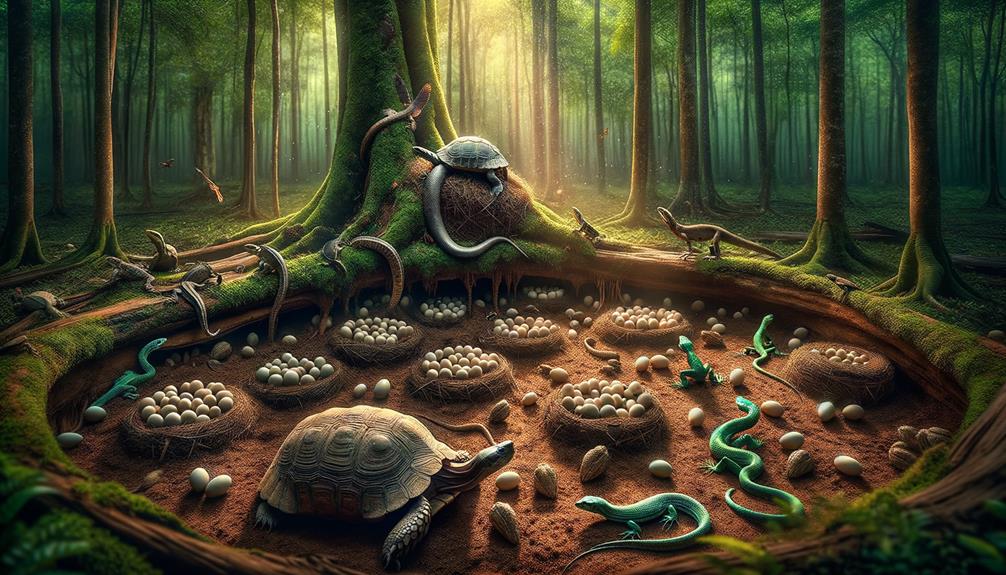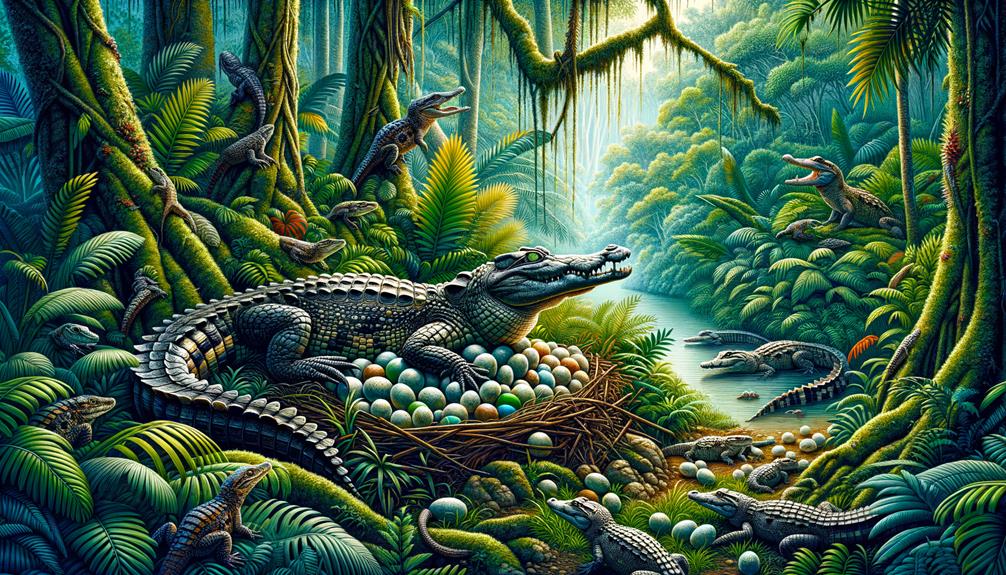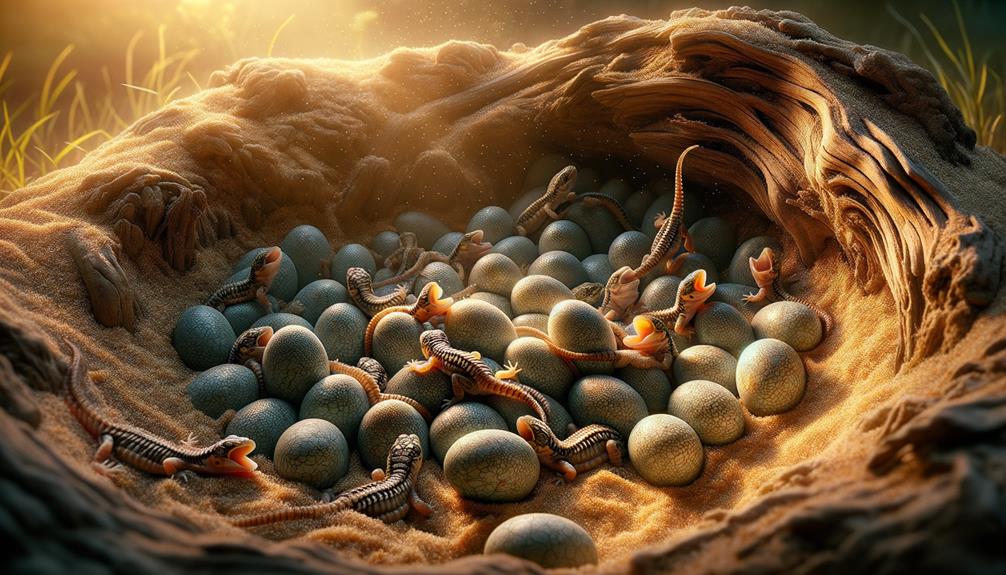I'm fascinated by the incredible way reptiles lay their eggs! Some reptiles, like turtles and crocodiles, produce soft-shelled eggs, while others, such as many lizards and snakes, lay hard-shelled ones. The variety in egg size and shape is astonishing, ranging from small, spherical gecko eggs to elongated snake eggs. Reptiles have diverse incubation periods, which can last anywhere from 45 to over 100 days, depending on the species and environmental factors like temperature. Their nesting habits are also impressive, with some constructing intricate burrows or nest mounds. If you're interested in learning more about these unique strategies, there's still much to explore.
Key Takeaways
Reptiles adapt their eggs to their environment, laying both soft-shelled and hard-shelled varieties. Incubation periods range from 45 days to over 100 days, depending on the species and temperature. Sea turtles exhibit strong site fidelity, returning to the same beaches to nest. Crocodilians take an active role in caring for their eggs, building nest mounds to protect them. When it's time to hatch, reptile young use a specialized egg tooth to break free from their shells.
Types of Reptile Eggs
When exploring the diverse world of reptile eggs, you'll find they come in various forms, each uniquely adapted to the needs of their species. The composition and structure of these eggs reflect the intricate balance between protection and the need for gas exchange.
Soft-shelled eggs, typical in turtles, crocodiles, and some lizards, have a more pliable exterior that allows for flexibility and moisture absorption. In contrast, hard-shelled eggs, common among snakes and other lizards, offer greater protection against environmental hazards and predators.
The eggshell composition is fascinating, with some shells being porous to facilitate essential gas exchange for the developing embryo, while others are thicker to provide enhanced security. This variation guarantees that each reptile species has an ideal environment for their eggs to develop.
Egg size and shape also vary widely, from the small, spherical eggs of geckos to the elongated, oval-shaped eggs of snakes.
Reptile egg-laying techniques differ as well. Some species build nests or bury their eggs in the ground, while others opt for sheltered areas, each employing unique incubation methods. This diversity in reproduction reflects the adaptability and survival strategies of reptiles.
Egg Incubation Periods

Understanding reptile egg incubation periods reveals a fascinating aspect of their reproductive biology, showcasing a remarkable range from 45 days to over 100 days depending on the species. Factors like temperature and development rates influence this diversity, making reptile incubation periods a captivating study.
Take, for example, monitor lizards and crocodilians. While smaller lizards might incubate their eggs in just 45 days, monitor lizards like the Komodo dragon take around 120 days. Crocodilian eggs, on the other hand, usually hatch after 80-100 days, with the Cuban crocodile being a slight exception at 70-80 days.
| Reptile | Incubation Period | Details |
|---|---|---|
| Lizards | 45-90 days | Smaller species develop faster |
| Snakes | 50-90 days | Species and environment affect incubation |
| Turtles | 60-120 days | Painted turtles take 2-3 months |
| Monitor Lizards | 60-120 days | Komodo dragon has the longest incubation |
| Crocodilians | 80-100 days | Cuban crocodile takes 70-80 days |
Temperature plays a critical role in the development of these eggs, affecting the duration and success rate. The incubation periods of reptiles are not just a waiting game, but a delicate process that requires specific conditions, making each hatchling's arrival an extraordinary event.
In reptile incubation, temperature is a key factor. It influences the development of the eggs and affects the duration and success rate. This delicate process requires specific conditions, making each hatchling's arrival a remarkable occurrence.
Nesting Habits

Exploring the nesting habits of reptiles reveals a remarkable array of behaviors and strategies that highlight their intricate relationship with their environments. Each species has developed unique ways to ensure the survival of their offspring.
When selecting a nest site, reptiles consider factors such as predation risk, soil composition, and temperature. Many opt for hidden or protected locations to shield their eggs from predators and environmental stresses. For example, sea turtles return to the same beaches year after year, demonstrating a strong connection to their birthplace.
Crocodilians construct elaborate nest mounds and provide active parental care. They vigilantly guard their nests and even assist their hatchlings in reaching the water, underscoring the importance of parental investment in these species. The soil composition and temperature of a nest site significantly impact the development of the eggs, influencing the sex ratio and overall health of the hatchlings.
In essence, the diverse nesting habits of reptiles reflect their adaptability and the delicate balance they maintain with their surroundings.
Egg Protection Strategies

Here's how reptiles cleverly protect their vulnerable eggs from predators and environmental threats. Many species deposit their eggs in hidden locations like underground burrows or rotting logs, effectively shielding them from potential predators.
Crocodilians take egg protection to the next level by building elaborate nest mounds made of vegetation and mud. These mounds not only camouflage the eggs but also provide insulation, maintaining ideal incubation conditions. Turtles, on the other hand, dig deep nest chambers and cover their eggs with soil, creating a natural barrier that conceals the eggs from predators and environmental hazards.
Snakes, like the common garter snake, take a more hands-on approach. They coil their bodies around their egg clutches, offering physical protection and warmth. This strategy ensures that the eggs are kept at a stable temperature during incubation.
Certain lizard species, like the common iguana, dig intricate nesting burrows with multiple chambers. These burrows provide a secure, sheltered environment for their eggs, safeguarding them from both predators and adverse weather conditions. Through these clever methods, reptiles demonstrate remarkable adaptability in protecting their future generations.
Hatchling Development

Hatchling development in reptiles is a remarkable process that highlights their adaptability and survival strategies from the moment they're born. When they break free from their amniotic membranes, hatchlings use a specialized tool called the egg tooth to slice open the eggshell. This tiny, temporary structure is vital for their emergence, allowing them to escape their initial confinement.
Many hatchlings don't immediately leave the nest after emerging. Instead, they might stay there during the winter, coordinating their behaviors with their siblings to ensure a synchronized and successful emergence. This collective strategy increases their chances of survival in the wild.
Some species use vocalizations to communicate with their mothers, which can prompt parental care behaviors, such as the mother helping her young leave the nest. This complex interplay of survival, involving both physical and behavioral adaptations, underscores the intricacies of reptilian life.
Here's a summary of key aspects of hatchling development:
| Aspect | Description | Importance |
|---|---|---|
| Egg Tooth | Temporary structure used to break the eggshell | Vital for initial emergence |
| Amniotic Membranes | Protective layers surrounding the embryo | Must be broken for hatchling to emerge |
| Vocalizations | Sounds made by hatchlings to communicate with parents | Triggers parental care and aids in emergence |
In essence, the journey from egg to independent hatchling showcases the incredible adaptability and coordinated behaviors necessary for survival in the reptile world.
Frequently Asked Questions
What Are Some Facts About Reptile Eggs?
Reptile eggs are fascinating! They have flexible, leathery shells, and the time it takes for them to incubate varies greatly. In some species, the temperature determines the sex of the hatchlings, and some reptiles even guard their eggs until they hatch.
How Do Reptiles Lay Eggs?
Reptiles lay eggs through a fascinating process that starts with internal fertilization as the eggs pass through the oviduct. Next, they search for or create a safe nesting spot to deposit their eggs, ensuring a suitable environment for incubation.
What Reptile Lays the Most Eggs?
The olive ridley sea turtle is a reproductive powerhouse, laying over 100 eggs per season in multiple clutches. This impressive breeding habit ensures the species' survival despite facing numerous natural threats.
How Long Does It Take for a Reptile Egg to Hatch?
The incubation period for reptile eggs varies greatly, ranging from about a month for smaller species to up to three months for larger ones. Both temperature and clutch size play a significant role in determining this duration, making it challenging to make precise predictions.



